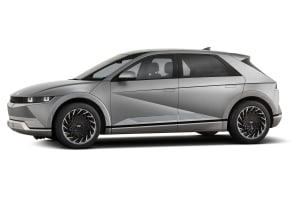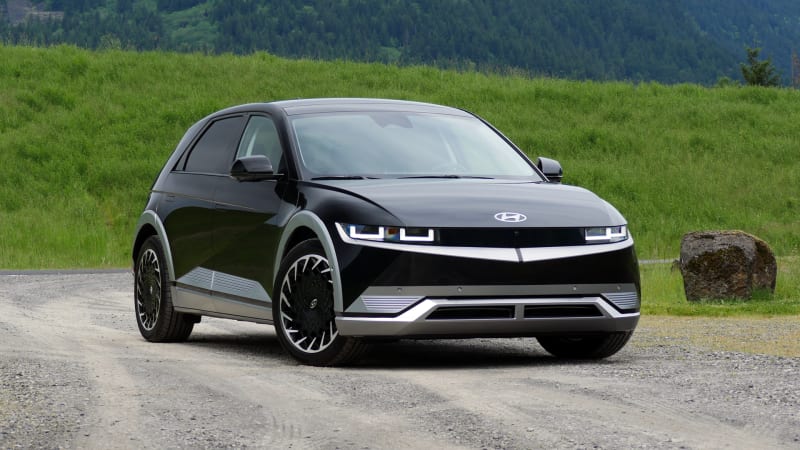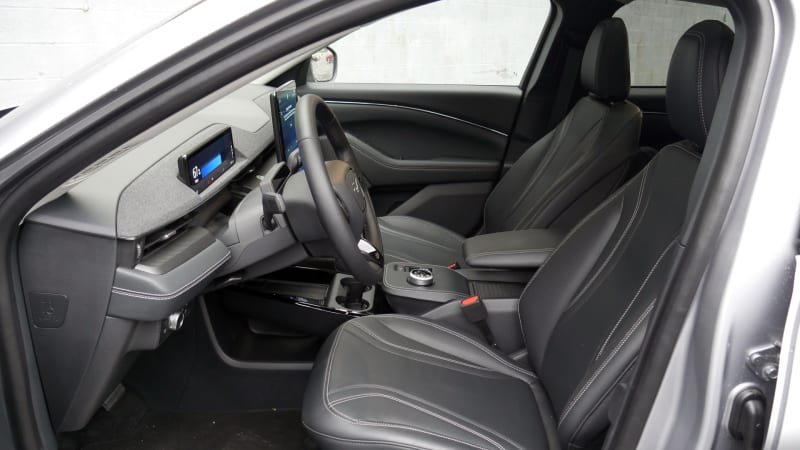If you had asked us 10 years ago what an electric car comparison test would look like, there’s a good chance we’d envision a pair of compact hatchbacks that were a bit slow, a lot dorky and not really appealing outside of the tree hugger set. The Tesla Model S was just reaching homes, but it was pricey, and it was hard to foresee it changing the automotive industry as it did.
Thank goodness our imaginations were so poor. The Hyundai Ioniq 5 and Ford Mustang Mach-E are not only electric cars, but they are two of the most interesting and flat-out cool cars to come along in the past few years. They’re definitely not slow, definitely not dorky and judging by how hard it is to get one (order books are already closed for the ’22 Mach-E), they definitely have wide appeal.
In the end, this comparison test was not close. Although the two test cars were about as closely matched as possible on price, equipment and specs, there was a clear winner once the points were tallied. Thing is, though, both are so good that even coming in a distant second is enough to be one helluva cool car … electric or otherwise.
The contenders
First up, the 2022 Hyundai Ioniq 5 Limited AWD. It’s the top of the line with an as-tested price of $55,940, including destination and $195 worth of floor mats. Like the Ford, it is eligible for the full $7,500 federal tax credit and falls under California’s maximum price threshold for getting that state’s $2,000 EV rebate. While the base Ioniq 5 has a 58-kilowatt-hour battery good for 220 miles, all other trim levels have the 77.4-kWh long-range battery. With rear-wheel drive, its single motor produces 225 horsepower and 258 pound-feet of torque. EPA-estimated range is 303 miles. Opting for all-wheel drive like our test car adds a motor to the front axle that results in a total output of 320 hp and 446 lb-ft of torque. Range drops to 256 miles.
Next, the Ford Mustang Mach-E. Although we literally tested a 2021 Ford Mustang Mach-E, it’s easy enough to see how much the same vehicle cost for 2022 (yes, past tense, order books are closed). In short, it would be $59,300 as tested – or about $4,000 more expensive than the equivalent ’21 Mach-E and our Ioniq 5 test car. That as-tested price includes the Mach-E’s optional, 88-kWh extended range battery. We appreciate that Ford gives you the option to get a higher trim level Mach-E without paying $5,000 extra for range you may not need.
The Mach-E battery/motor/drivetrain specs are even more complex than the Ioniq 5 because of that optional battery, but in short, the bigger battery yields more power and range, while opting for all-wheel drive adds more power but reduces range. Our test vehicle was a Mach-E Premium trim with the extended range battery (91 kWh versus 71) and all-wheel drive. All together, it produces 346 hp and 428 lb-ft of torque with an EPA-estimated range of 270 miles for 2022. Ford eked a handful of extra miles out of the battery for ’22, so it’s possible the results we found for the ’21 could be even better. Unlike the Hyundai, our Ford test car does not represent the pinnacle of Mach-E performance: that would the Mach-E GT.
Second Place: Ford Mustang Mach-E
Under normal circumstances, we would’ve weighted our scorecard so that value would’ve counted for more. Had we, the Mach-E would’ve been toast before this test even began. Its higher price for 2022 puts it at an even greater disadvantage against the Ioniq 5, plus the Ford has notably less equipment and worse charging capabilities. These are not normal circumstances, however, as the “suggested” in Manufacturer’s Suggested Retail Price has never been so meaningful. You’re going to be pay way more than sticker for both, and to make matters worse, order books are closed for the ’22 Mach-E. Basically, the situation is too uniquely complicated to weigh value too much.
Instead, the Mustang comes in second because the Ioniq 5 is just a bit better in most areas. The Mach-E is quick, but the Hyundai is quicker. The Mach-E has nicely modulated brakes with a well-calibrated one-pedal drive mode, but the Hyundai has multiple regeneration settings and an even more natural-feeling pedal. The Mach-E has the option of BlueCruise hands-free driving, but Hyundai’s overall suite of standard driver assistance features is superior. The Ford’s interior is well-made and functional with easy-to-use technology, but the Ioniq 5 basically matches it. Sometimes you can put in a good performance and just get beat.
There are areas where the Mach-E is superior, however. The first is cargo space. While the Ioniq 5 offers greater versatility thanks to its sliding back seat, you have to utilize that (and restrict back seat space in the process) in order to match the Mustang trunk’s basic space and functionality. You can see how much easier it was to fit the same bags in the two cars below (and note that we had to remove the cargo cover from the Ioniq). The Mach-E also has a more useful frunk, should that even matter.
Dive deeper into the cargo areas in our Mustang Mach-E Luggage Test and Hyundai Ioniq 5 Luggage Test
Ford also came out on top for range and efficiency. Both the Ioniq 5 and Mach-E were more efficient in our testing than their EPA estimates would indicate, but the Mustang did particularly well. It swallowed electrons at a rate of 32.26 kWh per 100 miles, which is better than both its EPA estimate (37 kWh/100 miles) and what we managed in the supposedly more efficient Ioniq 5. It saw 31.25 kWh/100 miles versus an EPA estimate of 34 kWh/100 miles.
Then again, this only works out to traveling an extra 0.1 mile per kWh (big whoop), but the 2022 Mach-E AWD with the extended battery also travels 22 miles further than the Hyundai. It also lost fewer miles of range during our drive than the Ioniq 5 did (96 miles vs. 113). These aren’t big differences, and the scorecard reflected that, but they’re advantages nevertheless.
As for disadvantages, the Mach-E was clearly behind the Hyundai in terms of comfort. The driver seat adjusts only six ways (the eighth that Ford advertises counts two-way lumbar, we don’t), while the seats themselves lack long-distance support and are disappointingly flat, leaving you to flop around when winding your way through corners. In this way, the Mach-E carries on a long-standing Mustang tradition. Ford needs to make the vastly superior GT Performance seats optional on lower trims.
Ride comfort is the bigger issue, though. The Mach-E rides firmer than the Ioniq 5 around town and on the highway, but then feels springy with ample body motions when pushed in the mountains. This discombobulated behavior is the worst of both worlds, but likely indicative of what the Mach-E really is: a competent midsize crossover given Mustang marching orders relatively late in its development.
That said, the Mach-E is still better for being a Mustang. It turns heads, especially when painted in our test car’s candy apple red paint, and we’d be just as enthused today with one in our driveways as we were when it arrived at the tail end of 2020. New kids have just arrived on the block since then.
First Place: Hyundai Ioniq 5
The Ioniq 5 earns a big victory by amassing small victories throughout the scorecard.
Hyundai’s 0-60 estimate may be slower than Ford’s (5.1 seconds vs. 4.8), but it sure feels quicker, possessing more snap when you whack the throttle (and Motor Trend’s testing confirms that). Its handling is also superior, with a playful, rear-happy nature that lets you whip it around corners like some sort of big, heavy Ford Focus R. The power distribution meter in the instrument panel even lets you see what your backside is feeling: that the rear motor carries a greater burden when powering out of a corner. You get a bit of this sensation with the Mustang, but not to the same extent. We scored the two EVs’ steering equally, but appreciated the Ioniq’s sharp turn-in and appropriate increase of effort when Sport mode is selected. Throw in the more composed suspension, and the Hyundai ironically aces the vehicle called Mustang in vehicle dynamics. The same upset occurred when we put the Mach-E up against the otherwise blah VW ID.4.
Inside, the scores for interior quality were even – both have a minimalist aesthetic that tends to make them look a bit cheap in pictures, but look closer in person, and you can appreciate the soft-touch materials and high-quality plastics. The Ioniq 5’s more premium switchgear was countered by the Mustang’s classy pleather and cloth dash trim. Scores for infotainment functionality and interior storage were also even – they’re both very good, but in different ways that may appeal more to one person than the next.
Yet, the Ioniq 5 also has clear, big-time advantages. There’s so much space between rows that the back seat can be slid all the way forward to expand cargo capacity, yet still have usable legroom behind a 6-foot-tall driver. When all the way back, however, there’s indeed more space between rows than in the Mach-E (something you really notice with a rear-facing child seat). You also sit a bit higher off the ground (and are therefore comfier), and benefit from air vents in the B pillar, two USB ports, sunshades and bigger, boxier windows that make it feel notably airier. The latter speaks to superior visibility in general. The front seats also scored higher, and not just because the Mach-E’s are so underwhelming: the range of adjustment is almost comical. While the Limited’s “Relaxation Mode” seat that includes a La-Z-Boy-style leg rest is of questionable use while waiting around for the car to charge (taller drivers won’t notice it at all, and shorter drivers might notice it poking them in the leg when not extended), the side effect ability to drop far down in the rear and tilt far up in the front is a boon for those longer of leg while driving. We do know that the SE and SEL trim level seats don’t adjust as much, but they still have traditional eight-way adjustability (not counting lumbar) and comfier seats.
The real ace up Hyundai’s sleeve is charging. Every Ioniq 5 features 800-volt electric architecture, which allows it to charge at a maximum of 250 kW and therefore utilize the increasing number of 350-kW fast charging stations. It can recharge from 10-80% at that max speed in 18 minutes. At a station with the more common 150-kW max charging rate, it can recoup the same amount in 25 minutes. That makes the Ioniq 5 one of the fastest-charging EVs, regardless of price. By contrast, the Mach-E maxes out at 150 kW and goes from 10-80% in 45 minutes. That’s 20 fewer minutes waiting around a Walmart parking lot with the Hyundai, which sounds like a pretty big advantage to us. And never mind this particular comparison: the only other EV in its price range to match the Ioniq 5’s charging speed is the mechanically related Kia EV6.
And finally, a category that wasn’t officially scored but that still matters to folks paying the bill: looks. The Mach-E may have drawn more admiring glances, but the retro-futuristic Ioniq 5 is cool in its own, totally different kind of way. Our test car’s combination of black paint and Limited-exclusive silver accents grants it a more upmarket vibe (News Editor Joel Stocksdale dubbed it the tuxedo livery), but there’s something about the Ioniq 5 that says “I’m different” without crossing into dork territory like early electrified vehicles. Then again, we spotted a teenage girl clearly mouthing “It looks kinda weird” to a friend as she walked past, so shrug.
In the end, the Ioniq 5 is in theory the smarter choice … if you actually had the ability to purchase either one at something akin to MSRP. But you can’t, and if anything, that’s actually another feather in the Ioniq’s cap: It’s at least easier to find one.
Related video:
Hyundai IONIQ 5 Information











